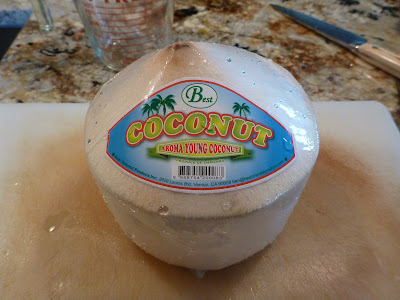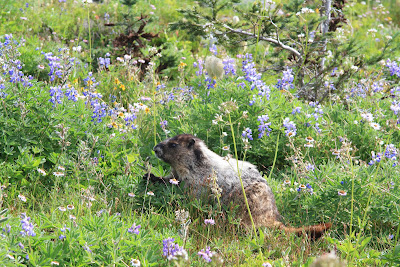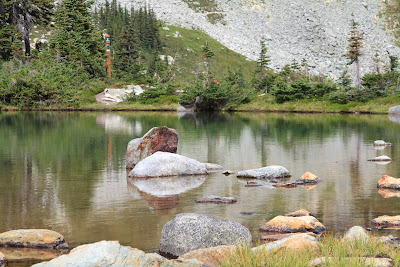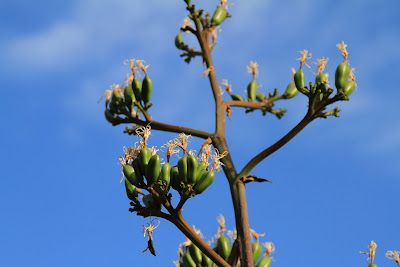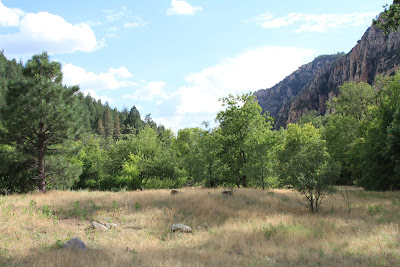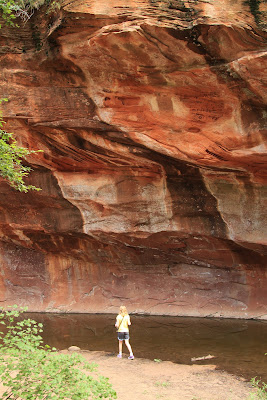Cocos Spelled Out Using Coconut Meat (left) and Cutting Board with Coconut Open and Coconut Water (right)


One day out of the blue we tried a young coconut and we were hooked. For six months now we’ve purchased and enjoyed a couple of coconuts a week. From an average young coconut we’ve typically gotten about 1 to 2 cups of coconut water. Not that weak stuff that is all the rage today, but real thick, tasty stuff. Then there is the meat. It's a perfect snack (at least for one half of Travelmarx). So it’s only natural that we would figure out how to feature the generic name Cocos with the food. The specific epithet nucifera was a bit too long to spell out.
In the process of preparing this post, we learned several things. First, we were opening the coconut (really the bottom of the coconut) the hard way. There are many videos showing the-whack-it-once and twist and off comes the cap. In the pictures here, we removed a large part of the coconut and there are ragged edges. Not so smooth. Oh well. There is the entertaining coconut-themed site Cooky Coconuts that has a lot of backstory about the coconut.
Second, we were removing the plastic wrap surrounding the young coconut, and most people suggest keeping it on while cutting. The The Commercial Storage of Fruits, Vegetables, and Florist and Nursery Stocks (see coconut section) says that commercially sold coconuts (all?) are dipped in 1 to 3% sodium meta-bisulfite for 2 to 5 minutes before wrapping. Sometimes fungicide is used. So to avoid possibly mashing any chemicals into your cutting board, keep the plastic on.
Third, why are they called young coconuts? Young coconuts (sometimes called young Thai coconuts because most seem to be a product of Thailand) are just immature coconuts, about 6 to 9 months old. The white part surrounding the young coconuts is called the husk (coir). The white meat inside the brown shell is endosperm or “spoon meat” because you can remove it with a spoon (though we just learned a hard spatula or ice cream scoop work nicely.) Spoon meat is what we wrote the word “cocos” with.
Fourth, coconuts are not nuts, but drupes. The “spoon meat” is solid endosperm and the liquid inside is liquid endosperm.
Finally, why are young coconuts shaped as they are when you see them at the grocery store? The ones we buy are conical at one end and flat at the other. Here are our guesses: 1) They are shaped this way for shipping considerations. When shipping uniformity is good and some non-round shapes are easier to pack. 2) The shape is traditionally how they are presented in countries where coconuts are grown? 3) The shape helps guide buyers in terms of how to use the young coconut. Pointy end is the end you should work with and remove to get inside. 4) The shape is a branding decision, unique to different growers. There are other possible shapes like diamond or teardrop.
In the pictures shown here, the coconut meat (endosperm) is separated from a piece endocarp (hard brown part) and then carved up to spell Cocos.
According to Quattrocchi Cocos has the following origin: “Portuguese and Spanish coco ‘mask, head, ape, bugbear, monkey face,’ the three scars on the base of the shell resemble a monkey’s face.” The specific epithet nucifera means “nut bearing”. It sounds better than drupifera?
Coconuts in the Grocery Store – Young on the Left and Mature on the Right (left) and Cocos in a Shell (right)


Our preparation of the young coconut. We have shaved the husk more than needed and we’ve cut the “top cap” off far down, more than is needed. Also, notice no plastic surrounding the husk. In the future, we’ll be keeping the plastic on considering the chance of chemical contamination of the cutting board. This coconut yielded about a cup and a half of coconut milk.
